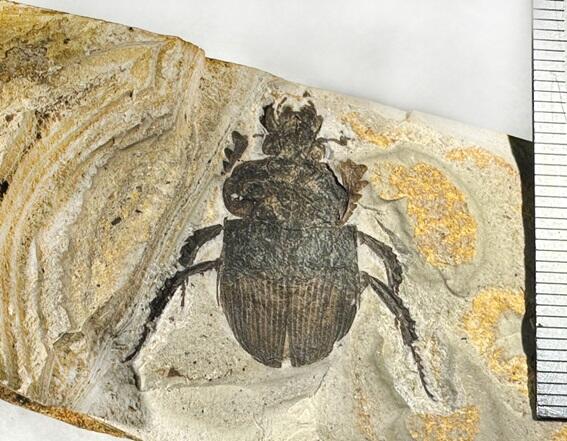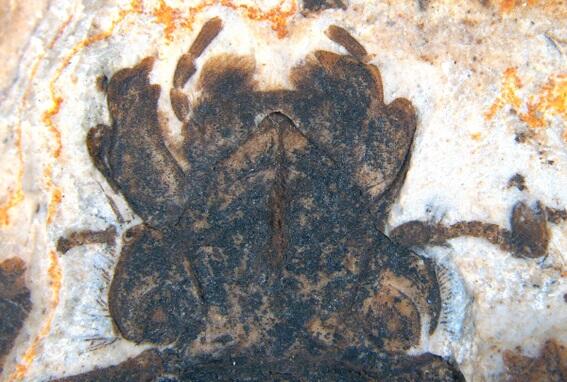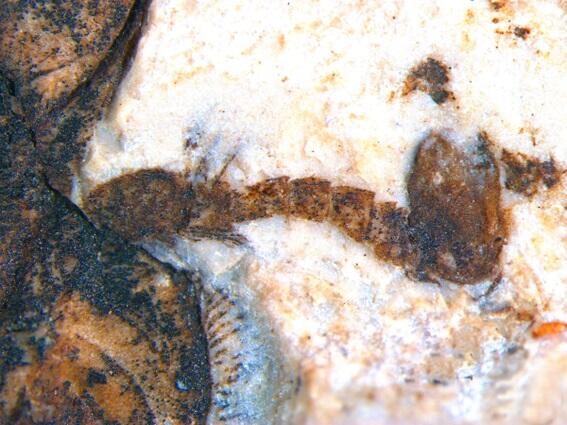An insect fossil discovered in class by a high school student was found to be a new insect species dating back 300,000 years. Hiroaki Aiba, a teacher at Keio Yochisha Elementary School, and Dr. David Král of Charles University in the Czech Republic reported the findings in Paleontological Research, the international journal of the Palaeontological Society of Japan.

Provided by Keio University
The fossil was discovered during a science class at Keio Senior High School in September 2022 when Kota Yatagai, then a third-year student (currently a first-year student in the Faculty of Environment and Information Studies at Keio University), cracked open a rock. The strata (300,000 years old) of Middle Pleistocene Shiobara Group, distributed on the site of the Konoha Fossils Museum in Nasushiobara City, Tochigi Prefecture, were excavated, and the rock featured in the aforementioned discovery was provided as an educational material.
Naoki Matsumoto, a teacher in charge of the compulsory course, Basic Earth Science, for third-year students, entrusted his research to Aiba. Aiba identified the fossil as a member of the genus Ceratophyus in the family Geotrupidae, which is not known to inhabit Japan. He considered it most likely to be a new species based on the shape of the mandibles and pronotum.
However, obtaining specimens for comparison was difficult because all specimens available had overseas origins, and some were listed as endangered species. Therefore, he asked Dr. Král, an expert in the genus Ceratophyus, for assistance. As a result, the fossil was confirmed as a new species. The new species was named Ceratophyus yatagaii in honor of its discoverer, Yatagai.

Provided by Keio University
The fossil was approximately 25 mm long and almost completely preserved. To date, 112 species of insect fossils have been reported; however, they either belong to extant species or are comparable to extant species. The first discovery of a new species that was extinct opens up the possibility of further discovery in the future.
In research conducted in Europe and other regions, the prevailing opinion is that most insect fossils from the Quaternary period belong to extant species. However, this discovery could potentially become valuable material for dating the differentiation of insects at the species level. Furthermore, the discovered fossil of the family Geotrupidae has no known relatives in Japan or the surrounding areas today. Its global distribution is fragmented, inhabiting areas around the Mediterranean Sea, Mongolia, Himalayas, Russia, inland regions of China, and California (United States). These areas are typically highlands and dry regions.
However, the distribution of Ceratophyus 300,000 years ago might have been significantly different from the current distribution, as data from plant fossils and other sources suggest that Japan was relatively warm and humid 300,000 years ago. This newly discovered fossil belongs to a type of species that feeds on the feces of herbivorous mammals. It is a valuable resource from a biogeographical perspective, providing an understanding of the kind of animal feces it might have consumed. Further, whether those animals became extinct in Japan can be explored.

Provided by Keio University
The fossil of the family Geotrupidae is rare throughout the world, with no more than 30 named species in total. New species from the Pliocene and Pleistocene periods had not been discovered until now. This fossil is considered the world's first new species starting from the Pliocene period, making it an extinct fossil species in the most recent period.
Journal Information
Publication: Paleontological Research
Title: The first fossil of Ceratophyus (Coleoptera, Geotrupidae) from the Middle Pleistocene Shiobara Group of Nasushiobara City, Tochigi Prefecture, Japan
DOI: 10.2517/PR230013
This article has been translated by JST with permission from The Science News Ltd. (https://sci-news.co.jp/). Unauthorized reproduction of the article and photographs is prohibited.




